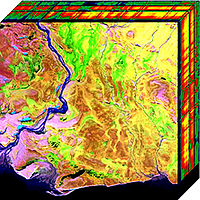
Photo from wikipedia
Band sampling (BSam) is an innovative concept for hyperspectral imaging, which is derived from signal sampling in communications/signal processing as well as sampling theory in information theory. It is quite… Click to show full abstract
Band sampling (BSam) is an innovative concept for hyperspectral imaging, which is derived from signal sampling in communications/signal processing as well as sampling theory in information theory. It is quite different from band selection (BSel) in several aspects. First of all, BSam ``samples'' bands with a given fixed BSam rate (BSamR) as opposed to BSel, which ``selects'' appropriate bands according to the number of bands to be selected. Second, BSam requires no specific means of sampling bands compared to BSel, which requires a specific rule to select bands such as band prioritization (BP) criteria or band search strategies. Third, BSam samples bands without prior band knowledge or specific applications in contrast to BSel, which considers certain bands more significant than other bands according to various applications. Two strategies are developed for BSam. One is from information theory. Under a completely blind and unknown environment, the maximum entropy is achieved by the uniform distribution. This suggests that one best strategy for BSam is uniform band sampling (UBSam). Another strategy is random BSam (RBSam) analogous to random signal sampling in compressive sensing (CS) where the bands sampled by RBSam are random but are not deterministic like the bands selected by BSel. Interestingly, UBSam and RBSam generally perform better than custom-designed BSel methods. To illustrate its potential utility of BSam in various applications, target detection, anomaly detection, and image classification are studied through extensive experiments for demonstration.
Journal Title: IEEE Transactions on Geoscience and Remote Sensing
Year Published: 2021
Link to full text (if available)
Share on Social Media: Sign Up to like & get
recommendations!